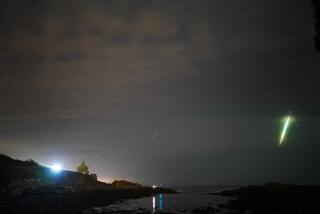The Perseid meteor shower -- set to hit its peak this weekend -- is expected to be “the best meteor shower of the year,” NASA says.
That’s because, in addition to the blizzard of shooting stars , some of the most stunning orbs visible to mere mortals will be on sparkling display at the same time.
The Perseid meteor shower is the glittery result of Earth’s passage through a steam of debris left behind by a period comet called the Swift-Tuttle, according to NASA. Reports of Perseid meteors are already rolling in and are expected to increase in intensity as the weekend gets underway.
Tweet us your Perseid photos at #LATPerseid
“We expect to see meteor rates as high as 100 per hour,” said astronomer Bill Cooke, the head of NASA’s Meteoroid Environment Office, in the above video. It was released by NASA on the aptly named website Space.com. “The Perseids always put on a good show.”
Cooke and his team will host an “Up All Night” live chat from Saturday at 11 p.m. to Sunday at 3 a.m. Participants will also get to see live video and audio feeds of the Perseid meteor shower from a camera mounted at the Marshall Space Flight Center.
NASA wants your help counting shooting stars this weekend
But the Perseid meteor shower is only part of the treat in store for stargazers, NASA says.
“The brightest planets in the solar system are lining up right in the middle of the [Perseid] display,” NASA says. Specifically, “Jupiter, Venus and the crescent moon are gathering together just as the Perseid meteor shower reaches its peak.”
The red giant star Aldebaran will also be visible, “adding a splash of color to the gathering,” NASA says.
The three celestial orbs will make for a brilliant, three-point line in the sky, all surrounded by shooting stars. The display is expected to be best seen in the eastern skies and in the early morning hours before sunrise.
The show will get better as the weekend winds down. Early Monday, the increasingly narrowing moon will pass even closer to Venus, as Jupiter “hovers” overhead, according to NASA.
This is one of those moments for which astronomy buffs live, according to NASA, which adds:
“Star-watchers say there’s nothing prettier than a close encounter between the slender crescent moon and Venus. Nothing that is, except for the crescent moon, Venus and a flurry of Perseids.”
ALSO:
Corn yields dive: Will we suffer at grocery?
Hawaii at a time like this? Judges’ Maui trip raises eyebrows
At memorial for Sikh temple victims: ‘We are bound together’
Join Rene Lynch on Google+ and Twitter. Email: [email protected]











